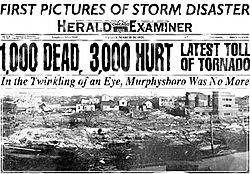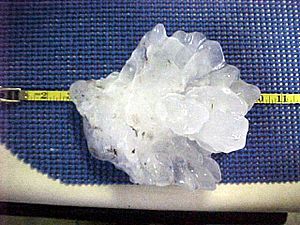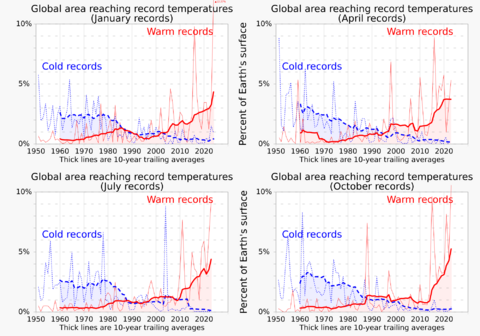List of weather records facts for kids
Have you ever wondered what the hottest, coldest, or windiest places on Earth are? This article lists some of the most amazing and extreme weather events ever recorded. Scientists measure these records carefully, often under specific conditions like air temperature a certain height above the ground, to make sure all measurements are fair and can be compared. Keep in mind that some records might have been broken before we had modern tools, or in very remote places without official weather stations. Also, measurements from satellites are not usually counted as official records.
Contents
Temperature Records: Hot and Cold
How We Measure Temperature
To keep things consistent, air temperature is usually measured about 1.25 to 2 meters (4 to 6.5 feet) above the ground. The thermometer is also protected from direct sunlight. This is why you often hear temperatures described as "in the shade."
Temperatures measured directly on the ground can be much hotter than the air, sometimes by 30 to 50 degrees Celsius (54 to 90 degrees Fahrenheit)! For example, a ground temperature of 93.9 °C (201 °F) was reported in Furnace Creek, California, in 1972. In 2011, 84 °C (183 °F) was recorded in Port Sudan, Sudan. Scientists think the ground could theoretically reach up to 100 °C (212 °F) in very dry, dark soil.
Satellites have also measured ground temperatures. Between 2003 and 2009, the Lut Desert in Iran recorded the highest satellite-measured ground temperature at 70.7 °C (159.3 °F) in 2005. For cold, satellites measured a surface temperature of -93.2 °C (-135.8 °F) in Antarctica in 2010. This is not an air temperature, but it suggests the air there would have been even colder than the official record.
Hottest Places on Earth
The highest air temperature ever officially recorded is 56.7 °C (134 °F). This happened on July 10, 1913, in Furnace Creek (Death Valley), California, USA. However, some experts question if this reading was completely accurate. Christopher C. Burt, a weather historian, thinks it might have been too high. He suggests that a reading of 54.0 °C (129.2 °F) from Death Valley on June 30, 2013, might be the most reliable highest temperature. Other places like Kebili, Tunisia (1931), and Tirat Zvi, Israel (1942), have also recorded temperatures around 54 °C (129.2 °F).
The former record of 57.8 °C (136 °F) from ʽAziziya, Libya, in 1922 was later found to be incorrect by the World Meteorological Organization (WMO).
Highest Global Average Temperature
The entire planet also has temperature records! The warmest day ever recorded for the whole Earth was July 6, 2023, with an average temperature of 17.08 °C (62.74 °F). July 2023 was the hottest month globally, and September 2023 was the most unusually warm month, being 1.8 °C (3.2 °F) hotter than temperatures before the industrial age.
Table of Hottest Temperatures by Country
| Country/Region | Temperature | Town/Location | Date |
|---|---|---|---|
| 51.3 °C (124.3 °F) | Ouargla, Ouargla Province | 5 July 2018 | |
| 52.2 °C (126.0 °F) | Sanbao Township, Turpan, Xinjiang | 16 July 2023 | |
| 54.0 °C (129.2 °F) | Ahvaz Airport (OIAW) | 29 June 2017 | |
| 54.0 °C (129.2 °F) | Tirat Zvi | 21 June 1942 | |
| 53.9 °C (129.0 °F) | Mitribah | 21 July 2016 | |
| 48.8 °C (119.8 °F) | Floridia, Sicily | 11 August 2021 | |
| 49.6 °C (121.3 °F) | Lytton, British Columbia | 29 June 2021 | |
| 56.7 °C (134.0 °F) | Furnace Creek, Death Valley, California | 10 July 1913 | |
| 50.7 °C (123.3 °F) | Oodnadatta, South Australia Onslow, Western Australia |
2 January 1962 12 January 2022 |
|
| 48.9 °C (120.0 °F) | Rivadavia, Salta Province | 11 December 1905 |
Other High Temperature Records
- Highest temperature during rain: 48.3 °C (119.0 °F) in Imperial, California, on July 24, 2018.
- Highest overnight low temperature: 44.2 °C (111.6 °F) in Khasab, Oman, on June 17, 2017. This means it was still incredibly hot even in the middle of the night!
- Highest temperature north of the Arctic Circle: 38.0 °C (100.4 °F) in Verkhoyansk, Russia, on June 20, 2020. This shows how much the Arctic is warming.
Humidity Records
Humidity makes hot weather feel even hotter.
- Highest dew point temperature: A dew point of 35 °C (95 °F) was recorded in Dhahran, Saudi Arabia, on July 8, 2003. The air temperature at the time was 42 °C (108 °F).
- Highest heat index: In the same event in Dhahran, Saudi Arabia, the "feels like" temperature (heat index) was an incredible 81.1 °C (178 °F)!
- Highest temperature with 100% relative humidity: 34 °C (93 °F) in Jask, Iran, on July 21, 2012. Imagine how sticky that would feel!
Coldest Places on Earth
The lowest air temperature ever officially recorded is -89.2 °C (-128.6 °F). This chilling record was set at Vostok Station in Antarctica on July 21, 1983.
Table of Coldest Temperatures by Country
| Country/Region | Temperature | Town/Location | Date |
|---|---|---|---|
| −23.9 °C (−11.0 °F) | Ifrane | 11 February 1935 | |
| −89.2 °C (−128.6 °F) | Vostok Station | 21 July 1983 | |
| −53.0 °C (−63.4 °F) | Mohe City, Heilongjiang | 22 January 2023 | |
| −67.8 °C (−90.0 °F) | Verkhoyansk and Oymyakon, both in Sakha Republic |
15 January 1885
5,7 February 1892 |
|
| −51.5 °C (−60.7 °F) | Pokka, Kittilä, Lapland | 28 January 1999 | |
| −69.6 °C (−93.3 °F) | Klinck Automated Weather Station, Greenland Ice Sheet | 22 December 1991 | |
| −63.0 °C (−81.4 °F) | Snag, Yukon | 3 February 1947 | |
(contiguous) |
−56.7 °C (−70 °F) | Rogers Pass, Montana | 20 January 1954 |
| −32.8 °C (−27.0 °F) | Sarmiento, Chubut Province | 1 June 1907 | |
| −25.6 °C (−14.1 °F) | Ranfurly, Central Otago | 18 July 1903 |
Other Low Temperature Records
- Coldest summer (month of July in the Northern Hemisphere): -33 °C (-27 °F) at Summit Camp, Greenland, on July 4, 2017. Imagine summer being that cold!
- Lowest temperature in the Northern Hemisphere: -69.6 °C (-93.3 °F) on the Greenland Ice Sheet, Greenland, on December 22, 1991.
Extreme Temperature Changes
Weather can change very quickly!
- Greatest 2-minute temperature increase: 27 °C (49 °F) in Spearfish, South Dakota, on January 22, 1943. The temperature jumped from -20 °C (-4 °F) to 7 °C (45 °F) in just two minutes!
- Greatest 24-hour temperature increase: A massive 57 °C (102.6 °F) increase in Loma, Montana, on January 15, 1972. It went from -48 °C (-54 °F) to 9 °C (48 °F).
- Fastest temperature drop: 27.2 °C (49 °F) in just 5 minutes in Rapid City, South Dakota, on January 10, 1911.
- Largest temperature range in one area: Verkhoyansk, Russia, has seen temperatures from -67.8 °C (-90 °F) to 38.0 °C (100 °F). That's a difference of 105.8 °C (190.4 °F)!
Precipitation Records: Rain and Snow
Precipitation is any form of water that falls from the sky, like rain, snow, or hail.
- Least rain per year: Quillagua, Chile, gets only 0.2 mm (0.008 inches) of rain or less each year. That's hardly anything!
Rain Records
- Most rain in 60 seconds (1 minute): 38 mm (1.5 inches) in Sainte-Anne, Guadeloupe, France, on November 26, 1970. That's a lot of rain in a very short time!
- Most rain in 24 hours (1 day): 1,825 mm (71.85 inches) in Cilaos, Réunion, on January 7–8, 1966, during Tropical Cyclone Denise.
- Most rain in one year: 26,470 mm (1,042 inches) in Cherrapunji, India, from 1860–1861. That's over 26 meters (86 feet) of rain!
- Highest average annual total: Mawsynram, India, averages 11,872 mm (467.4 inches) of rain per year over 38 years.
Snow Records
- Most snow in a 24-hour period: 90.6 inches (230 cm) of snow fell on Mount Ibuki, Japan, on February 14, 1927.
- Most snow in one calendar month: 9.91 meters (390 inches) of snow fell in Tamarack, California, in January 1911.
- Deepest snowfall recorded: 11.82 meters (38.8 feet) on Mount Ibuki, Japan, on February 14, 1927. Imagine snow taller than a three-story building!
- Lowest latitude for sea-level snow in North America: Snow fell as far south as Tampico, Mexico, in February 1895.
Wind Speed Records
Wind can be incredibly powerful.
- Fastest wind ever recorded: 484 ± 32 km/h (301 ± 20 mph) in a 3-second gust. This was measured by a special radar unit during the 1999 Bridge Creek–Moore tornado in Oklahoma, USA, on May 3, 1999.
- Fastest non-tornado winds: 408 km/h (253 mph) in a 3-second gust. This was recorded by an anemometer (wind speed measuring device) during Severe Tropical Cyclone Olivia on Barrow Island, Australia, on April 10, 1996.
- Fastest non-cyclone winds: 372 km/h (231 mph) in a 1-minute average. This was recorded on Mount Washington, New Hampshire, USA, on April 12, 1934.
Tornado Records

Tornadoes are powerful, spinning columns of air.
- Deadliest tornado on Earth: Approximately 1,300 deaths in the Daulatpur–Saturia tornado in Bangladesh on April 26, 1989.
- Deadliest tornado in North America: 695 deaths in the Tri-State Tornado, which swept through Missouri, Illinois, and Indiana, USA, on March 18, 1925.
- Largest and most severe tornado outbreak: The 2011 Super Outbreak. In just 24 hours, 207 confirmed tornadoes touched down, with a total of 337 during the entire event. These tornadoes hit six US states, including some of the strongest ever recorded (EF4 and EF5 ratings).
Tropical Cyclone Records
Tropical cyclones are huge storms that form over warm ocean waters.
- Most intense ever recorded (by lowest air pressure): 870 hPa (25.69 inHg) in the eye of Super Typhoon Tip over the northwest Pacific Ocean on October 12, 1979. Lower pressure means a stronger storm.
- Most intense in the Western Hemisphere: 872 hPa (25.75 inHg) in the eye of Hurricane Patricia over the eastern Pacific Ocean on October 23, 2015.
- Most intense recorded on land: 892 hPa (26.35 inHg) at Craig Key, Florida, USA, during the Labor Day Hurricane of 1935.
- Most precipitation from a single tropical storm: 6,433 mm (253.3 inches) from Cyclone Hyacinthe in Réunion in January 1980.
Other Extreme Weather Records

Hail Records
Hail is ice that falls from thunderstorms.
- Heaviest officially recorded hailstone: 2.25 lb (1.02 kg) in Gopalganj District, Bangladesh, on April 14, 1986. That's heavier than a can of soup!
- Largest diameter officially measured: 8.0 inches (20 cm) in diameter and 18.625 inches (47.31 cm) in circumference in Vivian, South Dakota, on July 23, 2010.
- Largest circumference officially measured: 18.75 inches (47.6 cm) in circumference and 7.0 inches (18 cm) in diameter in Aurora, Nebraska, on June 22, 2003.
Lightning Records
Lightning is a giant spark of electricity in the sky.
- Longest lightning bolt: 768 km (477 miles) on April 29, 2020, in the southern United States. That's longer than the distance from London to Paris!
- Longest duration for a single lightning flash: 17.1 seconds on June 18, 2020, in Uruguay and northern Argentina.
Ultraviolet Index Records
The Ultraviolet (UV) index measures how strong the sun's UV radiation is.
- Highest ultraviolet index measured: A UV index of 43.3 was detected at Chile/Bolivia's Licancabur volcano on December 29, 2003. At this level, someone with light skin could get a moderate sunburn in as little as 4 minutes!
Other Weather Categories
- Highest air pressure ever recorded (at high altitude): 1084.8 hPa (32.03 inHg) in Tosontsengel, Mongolia, on December 19, 2001. This is the pressure adjusted to sea level, but the location is 1,300 meters (4,265 feet) above sea level.
- The highest air pressure recorded closer to sea level was 1083.3 hPa (31.99 inHg) at Agata, Russia, on December 31, 1968.
See also
 In Spanish: Anexo:Récords meteorológicos mundiales para niños
In Spanish: Anexo:Récords meteorológicos mundiales para niños
- Extremes on Earth
- Climate change




